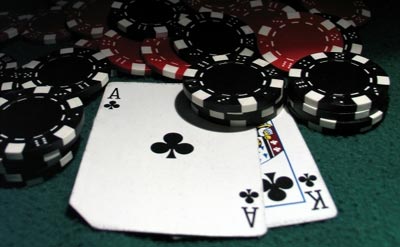Patents are not pat handsby Sam Dinkin
|
SidebarIn Texas Hold’em, two players make bets without seeing their cards called “blinds”, then everyone gets dealt two cards. Then everyone bets. Then five community cards are dealt: first 3 (called the “flop”), then there is a round of betting; 1 more (the “turn” or “4th street”), then another round of betting; then 1 final card (the “river”), then one last round of betting. The winner is the one who stayed in for all betting rounds and has the best five card poker hand made with up to two of the player’s own cards and up to five of the community cards. Texas Hold’em is played online and in casinos around the country. The two primary styles are ring games and tournaments. In ring games, players can enter and leave the game whenever they want. In tournaments, players must play the entire tournament to win and the winner is the player with all the chips at the end. |
While this is a great bet in a ring game, it may not be such a great bet in a tournament. In a ring game, a high payoff, high-risk proposition is fine. If you have a large bank roll, you can afford to make many high risk bets and enough of them will pay off in the long run for this to be an excellent strategy.
In a tournament, bets like this deplete a limited bankroll. That is, if you only have enough chips to play two or three hands, it might be worth giving up a little bit of expected value in order to lower the variance of the payoff. For example if you only have enough chips to play one of the next twenty hands, wait to play high cards and bet if you make top pair. Playing QJ, you “hit” on the flop 20.4% of the time when the flop contains a queen or jack and no ace or king (plus more for the chance of getting a straight). Since other bettors are likelier to fold if they see a king or queen on the flop and they don’t have one themselves, it is a lower risk, lower payoff proposition than playing a pair of deuces. Call it 7-1 payoff on a 4-1 bet. The bet has about the same edge as playing a pair of eights, but wins twice as often. In a tournament, your longevity is improved if you de-escalate the variance of your decisions.
A corporation deciding whether to file a patent is kind of like a Texas Hold’em player in a ring game. Patents hit about 3% of the time. If IBM makes $1.8B a year in patent royalties and files 3,000 patents a year, the envelope theorem tells us that they make about $600,000 per patent on average. Multiply that by 33.3 and you get $20 million in royalties per hit patent. It turns out more than half of hit patents don’t even make back their filing fees so the few that do have to average $50 million in royalties or so. Suppose it costs $50,000 per patent to file. If it hits big, you get 1000-1 on your money about 1% of the time. This is a great return, but few have the risk tolerance for it without a huge portfolio. IBM or Nathan Myrhvold’s Intellectual Ventures can make this work well. A solitary inventor or small startup cannot.
A startup, in contrast, is always struggling for cash much like a tournament Texas Hold’em player. A patent may reduce a startup’s chances of surviving long enough to get a successful product to market. A startup has a burn rate that is similar to the blinds in Texas Hold’em. Startups cannot afford risky bets outside their core product because it will eat through their bankroll. Startups should be making safe bets trying to manage the risk of their main product and stay afloat long enough to become profitable. The goal is winning the tournament and becoming one of the survivors.
The turn and the river
In Texas Hold’em, if you flop a third eight to make a set of eights, you can still lose to a flush or a straight. You need to bet and risk losing on the turn or the river. In patents, you hit your patent and you may need to sue other users to get any royalties. A patent requires a war chest to sue infringers. Winning in court is not a sure thing either.
| In a sense, a patent is an insurance policy that a firm will lose in the marketplace. |
A set of eights is worth the most when someone else makes a hand (like a set of sevens). If you are the only one to make a hand, it is not worth very much. Similarly, a patent is only worth something if another firm wins a high market share in a great market. Otherwise, the patent is not worth the enforcement costs. That is, if a firm has a product that wins in the marketplace like Microsoft Windows, that is worth far more than the royalties that Microsoft had to pay Apple on its patents. The market leader is less apt to sue because the risk of countersuit could harm their own product.
So in a sense, a patent is an insurance policy that a firm will lose in the marketplace. If a firm will be out of business in that event, it will not have a war chest to pursue the patent infringement case.
What this boils down to is that even though patents are a great investment for corporations, they might not be such a great investment for startups. They reduce the likelihood of winning in the marketplace and surviving long enough to succeed in favor of a high-payoff, high-risk insurance policy that only is worth pursuing if another firm dominates the marketplace.
